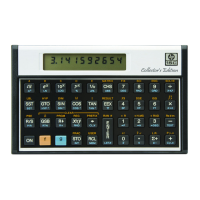22 Section 1: Getting Started
Calculations
One-Number Functions
A one-number function performs an operation using only the number in
the display. To use any one-number function, press the function key after
the number has been placed in the display.
45
45
| o
1.6532
Two-Number Functions and v
A two-number function must have two numbers present in the calculator
before executing the function. +, -, *, and ÷ are examples of
two-number functions.
Terminating Digit Entry. When keying in two numbers to perform an
operation, the calculator needs a signal that digit entry is terminated for
the first number. This is done by pressing v to separate the two
numbers. If, on the other hand, one of the numbers is already in the
calculator as the result of a previous operation, you do not need to use
the v key. All functions except the digit entry keys themselves
*
have the effect of terminating digit entry.
Notice that, regardless of the number, a decimal point always appears
and a set number of decimal places are displayed when you terminate
digit entry (as by pressing v).
Chain Calculations. In the following calculations, notice that:
The v key is used only for separating the sequential entry of
two numbers.
The operator is keyed in only after both operands are in the
calculator.
The result of any operation may itself become an operand. Such
intermediate results are stored and retrieved on a last-in, first-out
basis. New digits keyed in following an operation are treated as a
new number.
*
The digit keys, ., ”, “, and −.

